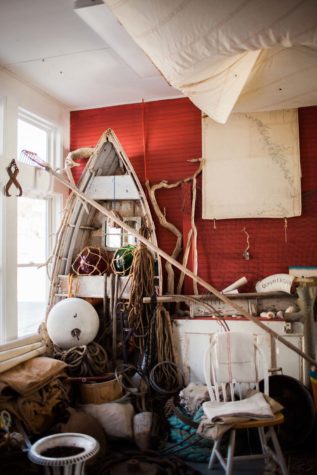Fit To Be Tied
Inside Marlinespike Chandlery in Stonington, you’ll find custom-made bell ropes and beckets surrounded by a stock of vintage buoys, wooden beads, rusted fishhooks, and other charming nautical relics
Like many girls before me, I discovered the quiet pleasure of tying knots just months before the noisy rush of junior high began. I remember those summer days of friendship knots and macramé as one of the last truly quiet times in my life; for hours, there was just the steady rhythm of fingers manipulating thread, the slow growth of intricate pattern.
A similar quiet descends as I examine the bell ropes and beckets at Marlinespike Chandlery in Stonington. These beautiful items are the work of chandlery owner Timothy Whitten, a fiber artist who creates woven straps, handles, and jewelry. The idea for a store, he explains, came after he had started selling these old-fashioned pieces of labor-intensive nautical art online. Whitten first began making bell ropes and beckets while he was working his way through graduate school. “I found myself rereading Moby-Dick and a few other related novels, and I wanted to build myself the quintessential wood chest, complete with handles on the end,” he remembers. As he began the process of building his chest, he became fascinated by the handles (called beckets). He began weaving and braiding natural twine, creating heavy, sandy-colored works of art. He calls them “samplers,” like embroidery samplers, because each piece allowed him to integrate a number of different braiding methods. The work, he discovered, suited him nicely.
In 2008 Whitten moved up to Maine and decided to open a store. Initially, Marlinespike Chandlery functioned as a gallery space for his art, but it was difficult to fill even a small space entirely with his labor-intensive fiber art. Soon, he started sourcing “related maritime artifacts and objects of interest,” he explains. “The theme of the shop is that it’s all stuff that grabs my attention. Assembled in the way that it is, the collection has resonated with people who find their way to my store.”
Unlike chandleries of the past, which sold primarily functional objects to seafaring types and their families, Whitten’s store is defined by aesthetic interest and curiosity value rather than everyday need. One doesn’t need a brass bell outfitted with a custom bell rope, nor does one require a hank of antique cord or a paint-chipped buoy. But these things are lovely in their faded, weathered way. “I think the whole space is inspirational for me,” Whitten says. “I collect nautical paraphernalia, like strings of cork floats or nets—all that maritime detritus.” He’s particularly drawn to Lignum vitae a type of rot-resistant wood. “It’s generally regarded as the densest wood in the world,” Whitten explains. “It’s favored for pulley parts and rigging implements because it’s so durable. It’s one of those magical materials—you hold it in your hand and you feel the density, the tightness of grain, and the polish it achieves. It’s very satisfying.”
Whitten’s reflective appreciation of antique wood is representative of his entire shop: the reason Marlinespike Chandlery works is because it’s a space where objects have history, purpose, meaning, and weight (both symbolic and literal). While he identified early on that much of his audience would be the “traditional maritime crowd,” Whitten has been pleased to discover his pieces also resonate with those who love art and with homeowners who want to surround themselves with fine, unique things. “I wasn’t fully aware of the customer base that Stonington and Deer Isle attract—there are a lot of artistic influences up here, and as I realized that, I began to look at my own work in a new way,” Whitten says. “It’s been an eye-opener for me.”
CURATE YOUR OWN MARITIME MUSEUM AT HOME
- One of the easiest ways to create a sense of cohesion is through collecting multiples of the same item, Whitten reveals. “Whether it’s a string of cork floats or a group of old fishhooks, I’ve discovered that I tend to display and assemble things in multiples,” he says. When displayed together, inglorious items like iron pulleys begin to take on new meaning. Scour flea markets for antique fishhooks, string them together, and hang them near an entryway for a unique piece of wall art. “I like the simplicity of basic shapes,” he adds.
- When hanging items, consider your wall color. “I have both dark colored walls and lighter ones in my shop,” says Whitten. “Light objects naturally pop on a dark wall, and darker pieces of rope look best against the white walls.” (Marlinespike is painted red, white, and blue. “That’s the color palette that appeals to me most,” Whitten says. “Traditional.”) Whitten suggests taking five or six lengths of old rope and hanging it against a rustic wall.
- Don’t throw out your lobster shells, and continue pocketing river rocks. “I like to make a short cairn from large, round beach stones,” Whitten says. “I also have a stack of graduating sizes of scallop shells, and another of clam shells.” Whitten even collects old lobster claws that he’s saved from dinner. “I clean them with a toothbrush and soap and water,” he reveals. “Then I cut the bottom so they stand upright.” Together, they create a textural display that would look fantastic next to a stack of old books or under a framed cluster of maps.








